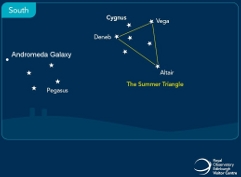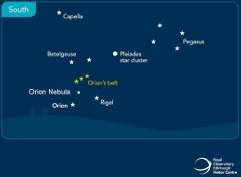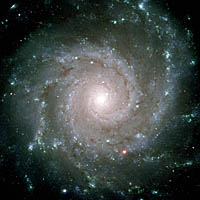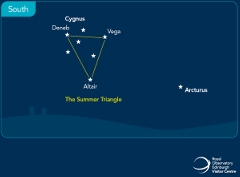The Night Sky
Get familiar with the night sky with our simple seasonal starcharts. We have also put together some top tips on stargazing and some pointers on taking a deeper look into astronomy
As well as the stars on these charts, you have a very good chance of seeing many other bright objects - the Moon, planets, space satellites and shooting stars (or meteors). These are all much closer to us than the stars and they change position – some fast, some slow - against the background of the constellations. Try Russell Eberst’s Skyview (or the many of the astronomy websites and magazines) for guides to what you can see each month.
Top Tips for getting the most out of Stargazing
It is easy to do stargazing - just go outside on a clear night and look up, wheverer you are there will be something to see. However there are a few things you can do to make the experience as breathtaking and memorable as possible. We have put together a collection of top tips to get the best out of your stargazing session.
A Deeper Look
So, you have found the stars and constellations in our starcharts. What next?
The night sky takes you into some of the big questions being explored today by research astronomers using powerful big telescopes.
Is there life elsewhere in the universe? Can we find it? These are huge questions for astronomy and for all of us. One place to search is planets around nearby stars that are Earth-like and which therefore might be home to life as we know it. Big telescopes have revealed that hundreds of nearby stars have planets around them. One of these stars is Vega in the Summer Triangle. In the 1990s the Royal Observatory Edinburgh built an instrument that detected planets around Vega – and revealed that these might be Earth-like. Find out more…
Vega is visible in the southern sky during the summer months from the UK as one corner of the Summer Triangle. Click on the starchart to the right for a larger image.
Galaxies – the starry sky and Andromeda
When you look up at a starry night, the stars look fairly even spread across the sky. But if you could look deeper into space, you would see that stars are in fact gathered in great groups, called galaxies, containing thousands millions of stars. The stars we see in the night with our naked eyes sky are all in our own galaxy, the Milky Way, which contains over 100 billion stars. There is just one object we can see with our naked eyes outside the Milky Way. It is our galaxy’s nearest neighbour the Andromeda Galaxy - and even this is no more than a smudge on a dark, clear night. Find out more…
Andromeda can be found above and left of the Square of Pegasus through the summer and autumn in the south. Click on the starchart for a larger image.
The life cycle of stars - Orion 
The winter seasons most recognisable constellation and one of its neighbours give us the ideal opportunity to observe stars in all the different stages of their life-cycles. As you look out into a clear night sky, you might notice some stars appear brighter, some fainter, some reddish tinted, some yellow, some blue-white. Why is this the case? What constitutes an old star? Find out more…
Orion dominates the southern sky through out the winter months. The Orion Nebula can be found on the sword, while following the line of the Belt up and right will bring you to the Pleiades star cluster. Click on the starchart to view a larger image.

